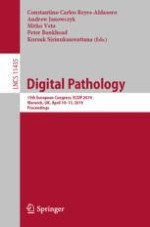2019 | OriginalPaper | Chapter
Multi-tissue Partitioning for Whole Slide Images of Colorectal Cancer Histopathology Images with Deeptissue Net
Authors : Jun Xu, Chengfei Cai, Yangshu Zhou, Bo Yao, Geyang Xu, Xiangxue Wang, Ke Zhao, Anant Madabhushi, Zaiyi Liu, Li Liang
Published in: Digital Pathology
Publisher: Springer International Publishing
Activate our intelligent search to find suitable subject content or patents.
Select sections of text to find matching patents with Artificial Intelligence. powered by
Select sections of text to find additional relevant content using AI-assisted search. powered by
